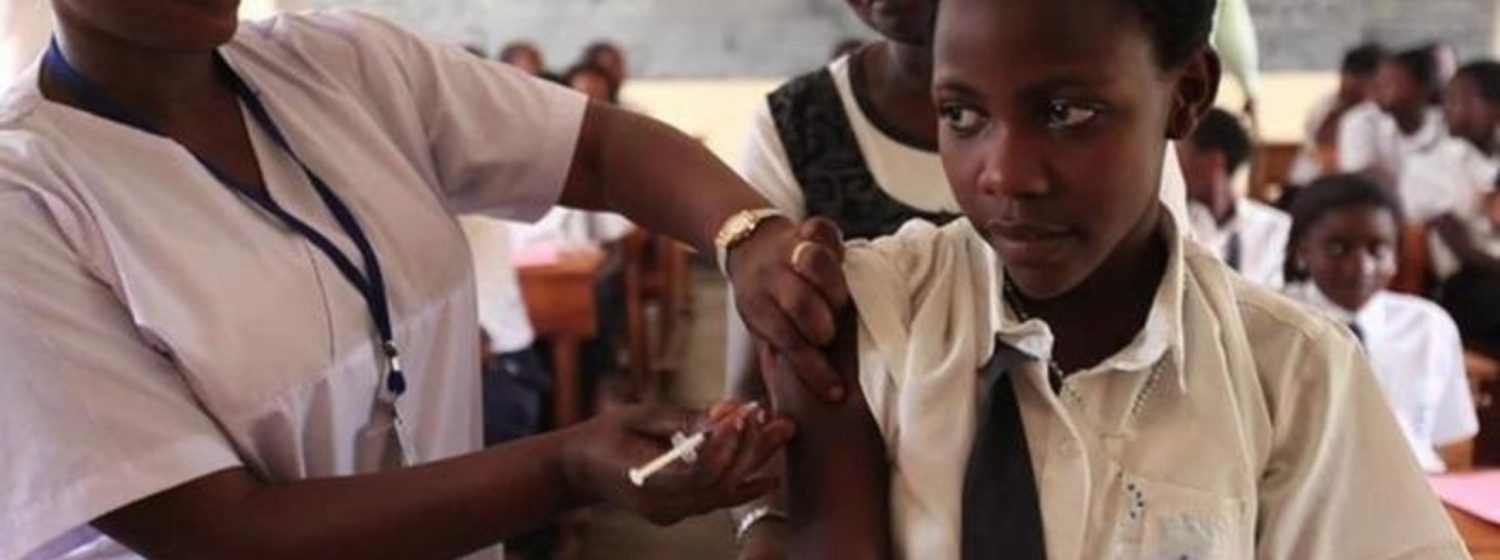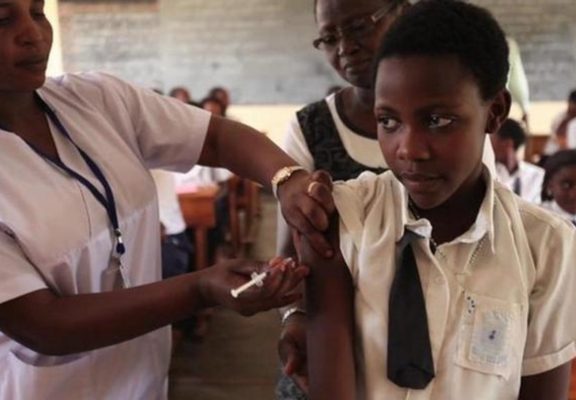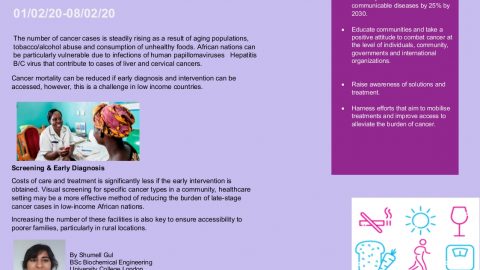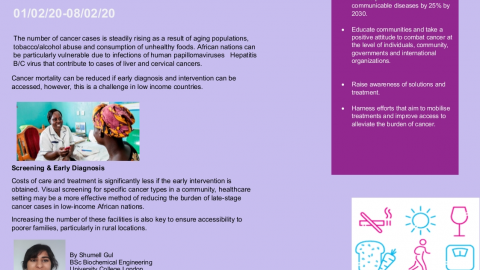

Africa Cancer Week
Key Facts
- Cancer is one of the leading causes of morbidity and mortality worldwide, with approximately 14 million new cases in 2012.
- The number of new cases is expected to rise by about 70% over the next 2 decades.
- Cancer is the second leading cause of death globally, and was responsible for 8.8 million deaths in 2015. Globally, nearly 1 in 6 deaths is due to cancer.
- Approximately 70% of deaths from cancer occur in low- and middle-income countries.
- Around one third of deaths from cancer are due to the 5 leading behavioral and dietary risks: high body mass index, low fruit and vegetable intake, lack of physical activity, tobacco use, and alcohol use.
- Tobacco use is the most important risk factor for cancer and is responsible for approximately 22% of cancer deaths.
- Cancer causing infections, such as hepatitis and human papilloma virus (HPV), are responsible for up to 25% of cancer cases in low- and middle-income countries3.
- Late-stage presentation and inaccessible diagnosis and treatment are common. In 2015, only 35% of low-income countries reported having pathology services generally available in the public sector. More than 90% of high-income countries reported treatment services are available compared to less than 30% of low-income countries.
- The economic impact of cancer is significant and is increasing. The total annual economic cost of cancer in 2010 was estimated at approximately US$ 1.16 trillion
- Only 1 in 5 low- and middle-income countries have the necessary data to drive cancer policy
- Cancer is one of the most prevalent diseases worldwide.
- Cancer is the second leading cause of death globally in 2015.
- Tobacco use is the most important risk factor for cancer.
- The most common types of cancer worldwide are: lung, liver, colorectal, stomach and breast cancer.
Cancer is a generic term for a large group of diseases that can affect any part of the body. Other terms used are malignant tumours and neoplasms. One defining feature of cancer is the rapid creation of abnormal cells that grow beyond their usual boundaries, and which can then invade adjoining parts of the body and spread to other organs, the latter process is referred to as metastasizing. Metastases are a major cause of death from cancer.
Cancer in Africa
The most common cancers in the African Region are cancers of the cervix, breast, liver and prostate as well as Kaposi’s sarcoma and non-Hodgkin’s lymphoma.
The rise in the number of cases of cancer is due to ageing populations and the increasing adoption of risk behavior such as: consumption of unhealthy diets, lack of physical exercise, harmful use of alcohol and tobacco use. In Africa, infections due to human papillomavirus and hepatitis B and C viruses significantly contribute to the burden of the top two cancers, namely cervical and liver cancer respectively.
Many lives can be saved if appropriate investment is made in raising public awareness on the early signs and symptoms of common cancers. In addition people should adopt healthy lifestyles that reduce the risk of cancers.
Causes
Cancer arises from the transformation of normal cells into tumour cells in a multistage process that generally progresses from a pre-cancerous lesion to a malignant tumour. These changes are the result of the interaction between a person’s genetic factors and 3 categories of external agents, including:
- physical carcinogens, such as ultraviolet and ionizing radiation;
- chemical carcinogens, such as asbestos, components of tobacco smoke, aflatoxin (a food contaminant), and arsenic (a drinking water contaminant); and
- biological carcinogens, such as infections from certain viruses, bacteria, or parasites.
Ageing is another fundamental factor for the development of cancer. The incidence of cancer rises dramatically with age, most likely due to a build-up of risks for specific cancers that increase with age. The overall risk accumulation is combined with the tendency for cellular repair mechanisms to be less effective as a person grows older.
Risk factors
Tobacco use, alcohol use, unhealthy diet, and physical inactivity are major cancer risk factors worldwide and are also the 4 shared risk factors for other noncommunicable diseases.
Some chronic infections are risk factors for cancer and have major relevance in low- and middle-income countries. Approximately 15% of cancers diagnosed in 2012 were attributed to carcinogenic infections, including Helicobacter pylori, Human papillomavirus (HPV), Hepatitis B virus, Hepatitis C virus, and Epstein-Barr virus3.
Hepatitis B and C virus and some types of HPV increase the risk for liver and cervical cancer, respectively. Infection with HIV substantially increases the risk of cancers such as cervical cancer.
Modify and reduce risk factors
Modifying or avoiding key risk factors can significantly reduce the burden of cancer. These risk factors include:
- tobacco use including cigarettes and smokeless tobacco
- being overweight or obese
- unhealthy diet with low fruit and vegetable intake
- lack of physical activity
- alcohol use
- sexually transmitted HPV-infection
- infection by hepatitis or other carcinogenic infections
- ionizing and ultraviolet radiation
- urban air pollution
- indoor smoke from household use of solid fuels.
Tobacco use is the single most important risk factor for cancer and is responsible for approximately 22% of cancer-related deaths globally
Early detection
Cancer mortality can be reduced if cases are detected and treated early. There are 2 components of early detection:
Early diagnosis
When identified early, cancer is more likely to respond to effective treatment and can result in a greater probability of surviving, less morbidity, and less expensive treatment. Significant improvements can be made in the lives of cancer patients by detecting cancer early and avoiding delays in care.
Early diagnosis consists of 3 steps that must be integrated and provided in a timely manner:
- awareness and accessing care
- clinical evaluation, diagnosis and staging
- access to treatment.
Early diagnosis is relevant in all settings and the majority of cancers. In absence of early diagnosis, patients are diagnosed at late stages when curative treatment may no longer be an option. Programmes can be designed to reduce delays in, and barriers to, care, allowing patients to access treatment in a timely manner.
Screening
Screening aims to identify individuals with abnormalities suggestive of a specific cancer or pre-cancer who have not developed any symptoms and refer them promptly for diagnosis and treatment.
Screening programmes can be effective for select cancer types when appropriate tests are used, implemented effectively, linked to other steps in the screening process and when quality is assured. In general, a screening programme is a far more complex public health intervention compared to early diagnosis.
Examples of screening methods are:
- visual inspection with acetic acid (VIA) for cervical cancer in low-income settings;
- HPV testing for cervical cancer;
- PAP cytology test for cervical cancer in middle- and high-income settings; and
- mammography screening for breast cancer in settings with strong or relatively strong health systems.
AHO Plan
- Reduce premature deaths from NCDs by 25% by 2030.
- Educate communities about cancer diseases and means to prevent them.
- Take a positive attitude to combat cancer at the level of individuals, community, governments and international organizations.
- Emphasize that solutions are possible and available, and we as individuals, government and non-governmental institutions and agencies can provide means of support, awareness and prevention of cancer.
- Harness efforts, capabilities and motivations for positive change and work to be open up to possibilities and expectations of positive impact on the global burden of cancer.
This event is under the auspices of Africa Health Organisation (AHO)



